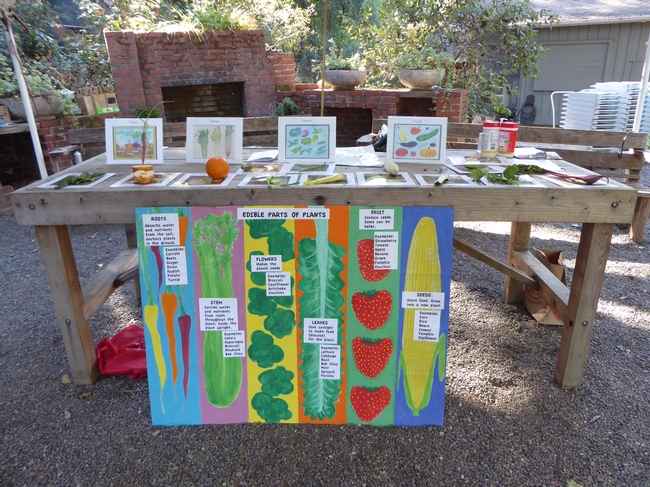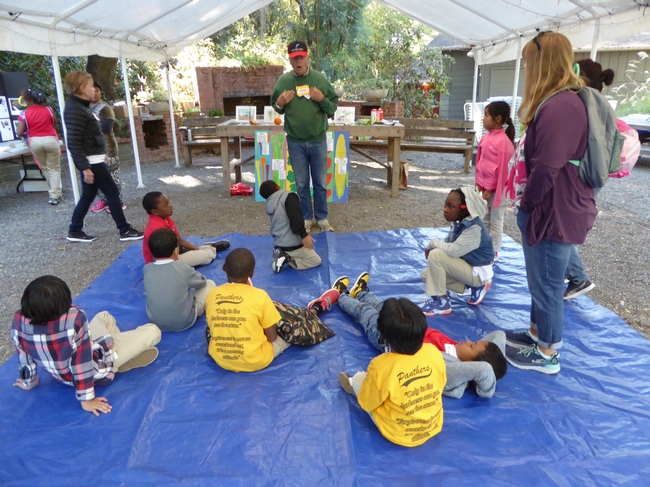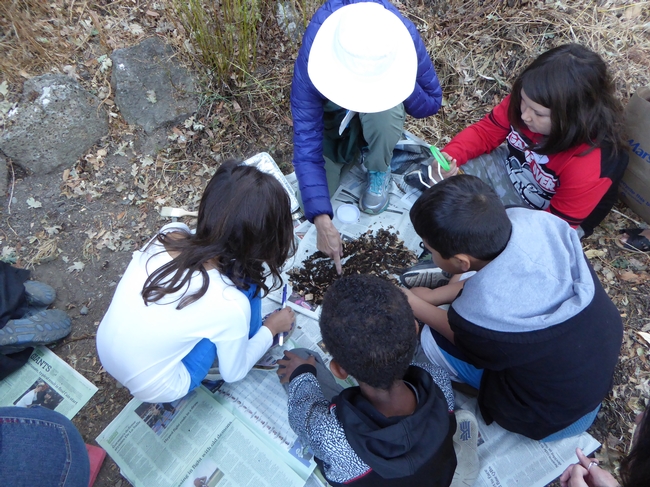
Posts Tagged: Community Gardens
Dig it, Grow it, Eat it: School gardens support learning and healthier food choices
The success of a garden is normally identified by plentiful crops of tomatoes and squash or the beautiful display of vibrant thriving flowers, shrubs or trees. However, a school garden's true success is dependent on the rich experiences and education students receive.
Taking the classroom into the garden
School gardens can play a big part in supporting a child's education outside of the traditional classroom environment; offering hands-on learning experiences in a variety of core curricula. Social sciences, language arts, nutrition and math are just a few of the many subjects that can be easily integrated into the school garden curriculum.
When paired with nutrition education, school gardens can transform food attitudes and habits.
“Gardens containing fruits and vegetables can change attitudes about particular foods; there is a direct link between growing and eating more fruits and vegetables,” said Missy Gable, statewide director for the UC Master Gardener Program. “Programs statewide connect people to local community gardens, or provide school administrators and staff the information needed to get started with their own school, community or home garden.”
“Dig it, Grow it, Eat it”
The UC Master Gardener Program of Marin County hosts an award-winning school gardening program that emphasizes engaging students with the many learning opportunities in nature. The program is a portable field trip for school-age youth called “Dig it, Grow it, Eat it.”
“Dig it, Grow it, Eat it” starts with University-trained UC Master Gardener volunteers training school educators. Once trained, educators use the curriculum to teach students how to grow edible plants from seed to harvest. UC Master Gardener volunteers help deliver the curriculum and provide additional resources. Students learn how plants grow, and receive nutrition lessons to give them a better understanding of the human body's need for healthy food.
The half-day workshop rotates groups of students through six stations providing them with garden enhanced nutrition education, linking health with growing and harvesting foods they like to eat and are good for them. These include:
- Edible Plant Parts
- How Plants Grow
- Plant Seed Science
- Propagation
- Soil Science
The “Dig it, Grow it, Eat it” curriculum is centered on the theme “We love the earth because we care for it. We care for the earth because we love it.” For many children, getting their hands dirty in the garden and discovering the science of growing their own food brings a sense of joy and pride they can carry with them for years to come.
Connect with us
The UC Master Gardener Program extends to the public free UC research-based information about home horticulture and pest management. In exchange for the training and materials received from the University of California, UC Master Gardeners perform volunteer services in a myriad of venues. If you are interested in becoming a certified UC Master Gardener contact your local UC Cooperative Extension office or visit mg.ucanr.edu.
Community and home gardens improve San Jose residents’ food security
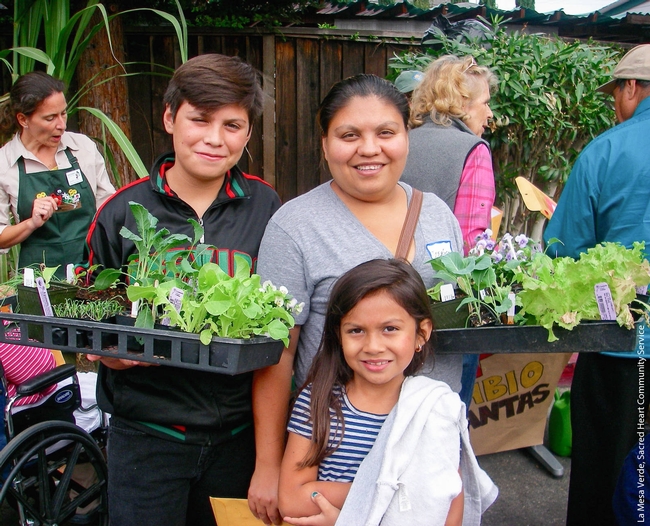
Participants in the pilot study, published in California Agriculture journal, reported doubling their vegetable intake to a level that met the number of daily servings recommended by the U.S. Dietary Guidelines. Meals rich in fresh fruits and vegetables are lower in calories and higher in fiber and part of a healthy diet.
About 13.5 percent of California households face food insecurity – reduced quality, variety or desirability of diet and, in some cases, reduced food intake – according to a 2014 USDA Economic Research Service study.
Although Silicon Valley is one of the wealthiest areas of the state, some parts of Santa Clara County have “food deserts,” low-income neighborhoods without grocery stores stocked with fresh fruits and vegetables at affordable prices. Even in neighborhoods with grocery stores, residents may have less to spend on food after paying rising housing costs.
“Gardening made a substantial contribution to vegetable intake regardless of socioeconomic background or previous gardening experience,” said co-author Lucy Diekmann, a postdoctoral researcher in the Food and Agribusiness Institute at Santa Clara University.

UC Cooperative Extension surveyed 85 community gardeners and 50 home gardeners in San Jose. The gardeners surveyed were generally low-income and came from a variety of ethnic and educational backgrounds. The survey was available in English, Spanish and Chinese.
By growing their own food, home gardeners saved on average $92 per month and community gardeners saved $84 per month.
A number of programs in California, including Sacred Heart Community Services' La Mesa Verde, help low-income families establish their own vegetable gardens. As of 2013, Supplemental Nutrition Assistance Program (SNAP) benefits can also be used to purchase seeds and plants so that low-income households can grow their own produce.
One gardener in the La Mesa Verde program told the researchers that without the savings and access to homegrown vegetables, she would have struggled the previous year. Her garden significantly supplemented her diet.
Wider variety of fresh produce
Tomatoes, cherry tomatoes, peppers, green beans and cucumbers were the most common crops grown by community gardeners. La Mesa Verde families were given seeds and plants to grow tomatoes, peppers, beans, basil, zucchini, radishes, cucumbers and eggplants.
Culturally favorite foods were also grown by San Jose's ethnically diverse residents in both community and home gardens. They grew crops including chayote, bitter melon, goji berries, green tomatoes, fava beans, okra, collards and various Asian vegetables, such as bok choy and mustards.
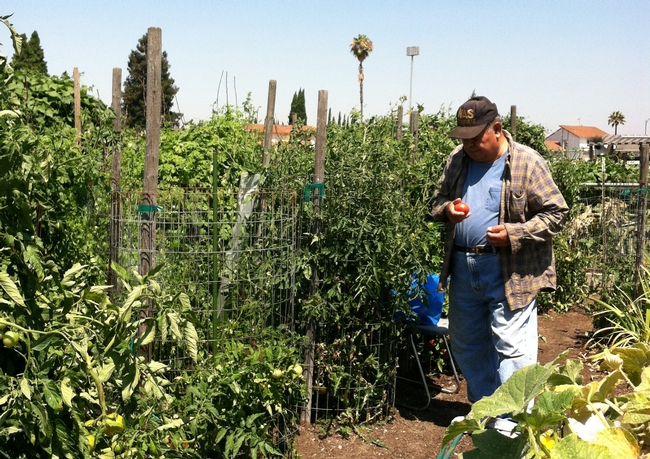
Gardeners in both groups gave excess produce to their friends and family members.
Growing demand for gardens
For the study, the authors collaborated with the San Jose Parks, Recreation and Neighborhood Services Department, which runs the city's Community Garden Program. The city operates 18 community gardens that serve more than 900 gardeners and occupy 35 acres in San Jose, yet there is growing demand for more gardening space.
“One of the challenges to starting a garden, particularly for low-income gardeners, is a lack of adequate space,” said Diekmann. “La Mesa Verde gardeners are advocating for San Jose to adopt Urban Agriculture Incentive Zones so that more San Jose residents can have space to garden.”
The study was conducted by UC Cooperative Extension advisor emeritus Susan Algert, Leslie Gray of Santa Clara University, Marian Renvall of UC San Diego Department of Medicine and Diekmann, whose participation in this study was funded by a USDA NIFA Agriculture and Food Research Initiative postdoctoral fellowship.
To read the full report in California Agriculture, visit http://ow.ly/wfWX300Dbzj.
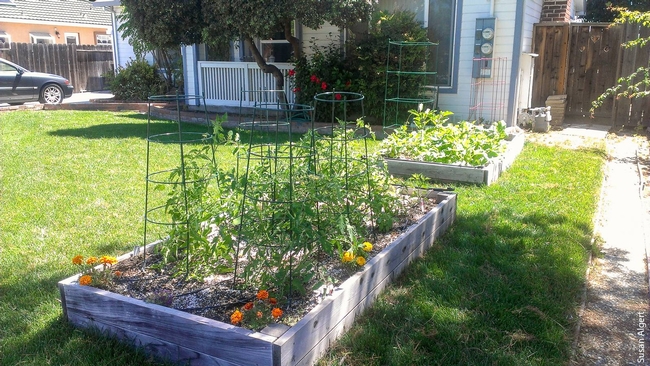
SNAP benefits can be used to purchase seeds and plants to grow produce.
UC Cooperative Extension takes community gardening to a new level in Riverside
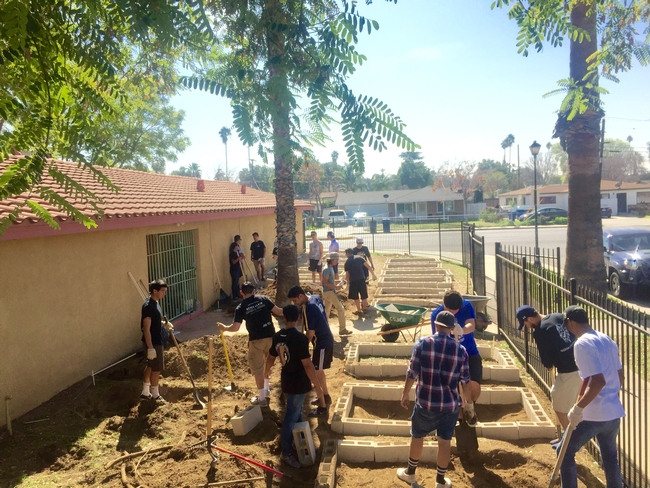
UC Cooperative Extension in Riverside County is bringing together students, agencies, nutrition educators and gardening experts to work alongside families to grow produce in garden plots at a community facility.
“Many people don't know how to get started gardening,” said Chutima Ganthavorn, the nutrition, family and consumer sciences advisor for UCCE and manager of its local UC CalFresh Nutrition Education Program. “Gardening takes space, water, resources like seeds and transplants, plus guidance and support. Our group is going the extra mile in Riverside County to help people grow and eat healthy food.”
This year, the local coalition received $10,000 in support from the Kaiser Permanente Heal Zone project to expand a vegetable garden at the Community Settlement Association (CSA), a center where community members gather for UC CalFresh nutrition classes, weekly food distributions and other services.
“A few years ago, the garden plots at the Community Settlement Association were neglected and weedy, while families struggled to get healthy food,” Ganthavorn said. “UC CalFresh teamed up with UCCE Master Gardeners and CSA staff to turn them into bountiful and beautiful edible gardens. Now our coalition is growing to include UCR Community Garden and Heal Zone members, including folks from City of Riverside Parks and Rec and Riverside Community Health Foundation.”
In 2014, UC Master Gardener volunteers, nutrition educators and members of the community planted vegetables in five existing garden boxes at Community Settlement Association, 4366 Bermuda Ave. in Riverside.
For planting day, neighborhood families – many who had taken part in UC CalFresh nutrition classes at the CSA – tilled the ground and planted seeds and transplants to grow tomatoes, bell peppers, summer squash, lettuce, green beans and Swiss chard.
“We're fixing up a garden for the children,” said Gonzalo Rodriguez, who joined planting day with his family. “We're planting chili and tomato transplants and seeds, food that will provide vegetables and give the children the joy of caring for the plants.”
In 2015, UC CalFresh arranged a $500 grant from Wood Streets Green Team, a local group that promotes sustainable living, to purchase fruit trees. Master Gardeners led volunteers to plant blackberry bushes, and peach, pluot, nectarine, plum, fuji apple and mini mandarin trees. They also planted quince, pomegranate, lemon and lime trees donated by a Master Gardener.
With the Heal Zone funds and support from UC Riverside student Claudia Villegas, the recipient of a Global Food Initiative Fellowship from the UC Office of the President, an extended garden began to take shape.
Villegas recruited students from Sigma Alpha Epsilon and Phi Chi Theta fraternities to transform a lawn at the community center with cinderblock raised beds. She is coordinating training sessions and encouraging local families to visit.
“I want the community to feel comfortable coming to the garden,” said Villegas, a senior psychology major. “I want them to just come in and hang out and interact and talk about gardening problems.”
The raised-bed plots have been assigned to families in the community.
“They feel ownership and maintain the gardens,” Ganthavorn said. “They can keep the produce they grow, and any extra produce goes to the weekly food distribution program at CSA.”
A gardening club now meets from 9 to 10 a.m. the first Thursday of each month at the community garden. UC Cooperative Extension coordinates gardening workshops with UC Master Gardener volunteers and nutrition and cooking sessions with UC CalFresh educators.
A 4-H club for children in the community is also being developed at the CSA site by Claudia Diaz Carrasco, UCCE 4-H Youth Development advisor. The purpose of 4-H clubs is to help diverse young people discover and develop their potential and grow into competent, contributing, and caring citizens.
“We believe that CSA children will benefit a lot by participating in 4-H learn-by-doing activities within the club,” Diaz said. 4-H clubs usually meet in the evenings or on weekends and offer self-chosen multiple learning experiences.
Gardens contribute vegetables, ease hunger among San Jose residents

A diet containing lots of vegetables is lower in calories and higher in fiber and good for our health. Yet, not everyone has easy access to fresh vegetables in the United States.
“Growing vegetables and having a garden is an effective intervention to promote increased vegetable consumption among all Americans,” said Susan Algert, UC Cooperative Extension advisor in Santa Clara County, who conducted the survey. “This is evidence for bringing back popular home gardens or ‘Victory gardens' of the past rather than investing exclusively in SNAP benefits for purchased foods.”
SNAP, the federal Supplemental Nutrition Assistance Program (formerly called food stamps), now allows participants to buy seeds with their benefits, which helps low-income people who want to grow their own veggies, she said.
Vegetable consumption falls well below the U.S. Dietary Guidelines in much of the U.S., particularly among African American, Latino, low educational attainment, and low-income populations.
Algert and fellow UC Cooperative Extension researchers looked at background characteristics, vegetable intake and program benefits of people who cultivated a home garden versus those who participated in a community garden.
“The home gardeners were significantly younger, had lower incomes, were less likely to have completed college and were more ethnically diverse than the community gardeners,” said Algert, who specializes in nutrition. “In other words, the background characteristics of the two groups varied significantly. In spite of these significant demographic differences, both groups increased their vegetable consumption from the garden to the same extent, by about two servings.”
In fact, by supplementing with food from their gardens, both groups met the U.S. Dietary Guidelines for recommended daily servings of vegetables to promote optimal health.
A lack of experience as gardeners didn't affect the results much. Fifty eight percent of the home gardeners reported having less than two years of experience whereas only one-third of community gardeners were novices.
“This study demonstrates that growing fresh vegetables in either a home or community garden setting can contribute significantly to a person's nutritional intake and food security at all income levels by making it a more affordable to maintain a healthful diet,” said Algert. Urban gardeners also experience a number of other benefits including exercise, stress release, and learning about gardening from their peers and mentors.
The study was a partnership with the Parks, Recreation and Neighborhood Services Department of the City of San Jose and La Mesa Verde, a project of Sacred Heart Community Services of San Jose. The UCCE research group worked with the Parks Department to administer a 30 question background survey to 83 community gardeners in four different gardens during April through September 2012. The same survey, slightly modified, was administered to a group of 50 home gardeners participating in Sacred Heart's La Mesa Verde project between September 2013 and April 2014.
Community gardens help stretch food dollars

This month Susan Algert, UC Cooperative Extension nutrition advisor, published research that shows gardeners can save money by growing their own vegetables.
“Low-income people in cities may be able to improve their nutrition by eating fresh vegetables grown in community gardens,” said Algert, who works with UC Cooperative Extension in Santa Clara, San Mateo and San Francisco counties.
To better understand how community gardens affect the affordability and amount of food available, she recruited 10 gardeners in San Jose to weigh the vegetables they harvested from their community gardens during the spring and summer.
The most common crops they grew were tomatoes, squash, green beans, peppers, onions, eggplants and cucumbers.
The citizen scientist gardeners harvested an average of 0.75 pounds of vegetables per square foot, which is more than the 0.60 pounds of vegetables per square foot USDA calculates as the typical harvest from conventional farming.
Algert found that community gardens produced on average 2.55 pounds of food per plant over the four months. For the season, buying the same vegetables at retail prices would have cost $435 more. People saved more money by growing more high-value crops such as tomatoes and peppers that grow vertically and occupy less ground space, she learned.
“We know that community gardens can be an important source of fruits and vegetables for people who don't live near a grocery store or a farmers market,” said Algert. “This study shows that vegetables from community gardens can also be more affordable than buying from a store. That's important to people who live on a low or fixed income.”
The amount of money people save by growing their own vegetables will vary. “Our citizen scientists who worked on this study are all experienced gardeners,” she said, “A novice gardener would likely need training to get the same results.”
Currently Algert is studying the amount of food grown in backyard gardens of low-income families in San Jose.
“It's a wonderful collaboration of nutrition educators, UC Cooperative Extension small farm advisors, UC Master Gardeners, Santa Clara University and Sacred Heart/Catholic Charities,” said Algert.
Her research team is metering water usage to include in their calculations of the cost of growing the food. The UC Master Gardeners have provided soil, raised beds, seeds and drip irrigation to families who are eligible for CalFresh assistance, formerly called food stamps.
In addition to fresh produce, gardeners get some exercise. “Gardening is an excellent form of physical activity,” said Algert.
The study “Vegetable output and cost savings of community gardens in San Jose, California” is published in the July edition of the Journal of Academy of Nutrition and Dietetics at http://www.andjrnl.org.
The community garden study was conducted in collaboration with the City of San Jose's Parks, Recreation and Neighborhood Services Department, which manages 18 community gardens on 35 acres of land.

